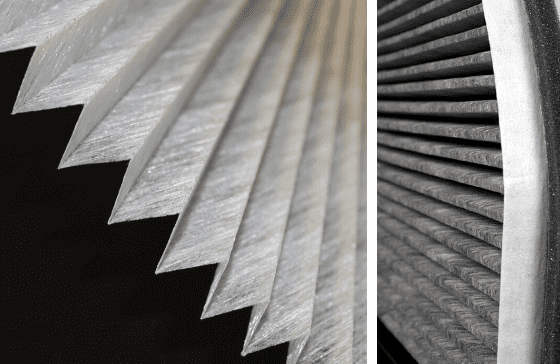When using an automatic filter pleating machine, testing pleat uniformity ensures that each filter element meets stringent quality standards. Uneven pleats can affect flow characteristics; therefore, visual inspection, digital measurement, statistical sampling, real-time monitoring, and data analysis are necessary. First, understand that pleat uniformity affects dust holding capacity and pressure drop. Second, recognize that even minor deviations in pleat height or spacing can cause localized channeling or premature plugging. Finally, please realize that the pleating machine itself must be systematically tested.
Visual Inspection Techniques for Automatic Filter Pleating Machines
One of the most straightforward ways to test pleat uniformity on an automatic filter pleating machine is to perform a structured visual inspection. Filter elements continuously emerge from the pleating machine. The operator then stops the line at prescribed intervals and performs a quick scan under standard shop lighting. For example, a portable LED ring light can be used to highlight the contrast between pleat peaks and valleys. Next, check the alignment of the pleats, consistency of spacing, and any signs of pleat deformation or tilt. Using a pleat gauge not only speeds up the inspection but also ensures a repeatable pass/fail assessment. Additionally, visual inspections should include a side-by-side comparison of the new sample with a gold standard reference filter element. By combining the two, differences in pleat profile, crease sharpness, and end seal flatness become apparent.
Measure with digital tools
Accurate pleat uniformity testing on an automatic filter pleating machine typically requires digital measurement tools. Benchtop digital calipers can measure pleat height and valley depth to within 0.01 mm; however, for increased efficiency, many quality engineers utilize 3D laser scanners. Meanwhile, handheld laser measurement probes provide real-time dimensional data without requiring contact with the pleated media. In contrast, traditional calipers force technicians to remove and manually measure the filter element.
To perform a digital scan, mount the filter element on a rotatable fixture and sweep the laser probe across the pleated surface. The resulting 3D point cloud reveals the differences between pleats, enabling the calculation of standard deviation and maximum deviation values. I recommend configuring the scanning software to automatically flag any pleats that exceed ±0.5 mm of the nominal profile. Additionally, digital microscopes with integrated measurement overlays can capture high-resolution images of the pleats, allowing for a detailed inspection of pleat sharpness and potential micro-tears.
Statistical Sampling Approach for Automated Filter Pleating Machines
No matter how advanced the inspection tools are, testing every filter on an automated filter pleating machine is often not feasible in high-volume production. This is where statistical sampling comes in. By applying the ANSI/ASQ Z1.4 sampling plan, we determine the appropriate sample size and randomly select units for detailed uniformity testing. For a batch of 1,000 filters with an AQL of 1.5%, we choose 40 filters. This allows us to gain statistically significant insights without having to inspect every filter element. The sampled filters are visually and digitally inspected, and we track defect types on a Pareto chart. Operators then calculate process capability indices to quantify how well the filter pleating machine maintains uniformity about the specification limits.
Real-time Monitoring Solutions
To elevate pleat uniformity testing from a periodic check to ongoing oversight, many manufacturers have deployed real-time monitoring systems on their automatic filter pleating machines. By installing linear displacement sensors at key pleat forming stations, the machine can capture pleat height and pitch data for each cycle. For example, a laser sensor mounted above the discharge roll tracks changes in pleat height; thus, any deviation exceeding ±0.5 mm triggers an alarm and halts production.
Integrated PLC logic aggregates sensor readings at each roll change and displays a real-time trend graph on the HMI, allowing operators to detect gradual drift. Dahe’s intelligent servo-driven tensioner automatically adjusts pleat depth, closing the loop and maintaining consistency without human intervention. Real-time monitoring prevents unacceptable pleats from accumulating, significantly cutting scrap and rework.
Calibration and Maintenance for Consistency
Maintaining the accuracy of any testing regimen on an automatic filter pleating machine depends on regular calibration and machine maintenance. First, the displacement sensor is calibrated monthly against a gauge block standard to ensure measurement fidelity. Then, quarterly die alignment checks using laser alignment tools ensure that the pleating rollers engage the fabric at precise angles.
In addition, worn pleating dies, and rollers are replaced proactively to prevent pleat deformation due to tool fatigue. Operators can adjust daily roller pressure to offset minor tool wear and lubricate the drive chain to prevent premature wear while ensuring smooth operation. By carefully calibrating measuring instruments and maintaining pleating components, you can maintain nominal pleat profiles and conduct consistent uniformity tests, ensuring that every output of the filter pleating machine meets strict quality standards.
Guaranteeing Pleating Uniformity
Testing pleat uniformity on an automatic filter element pleating machine requires a multifaceted strategy that begins with structured visual inspections, enhances accuracy through digital measurement, utilizes statistical sampling to improve efficiency, and implements real-time monitoring for immediate feedback. All of these methods are based on regular calibration and preventive maintenance to ensure that both the inspection tools and the pleating machine itself are in optimal condition.





